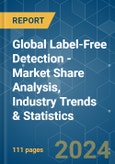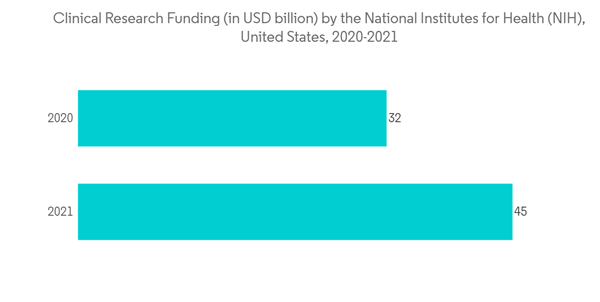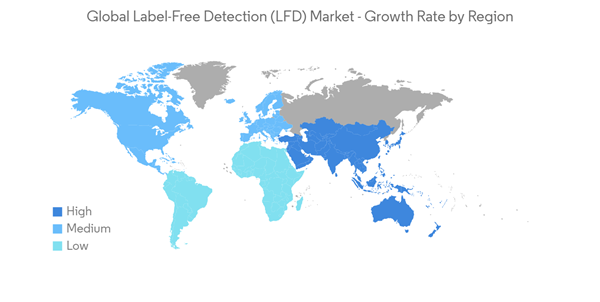The Global Label-Free Detection Market size is estimated at USD 1.72 billion in 2024, and is expected to reach USD 2.98 billion by 2029, growing at a CAGR of 11.60% during the forecast period (2024-2029).
The COVID-19 pandemic has had a substantial impact on the label-free detection market initially. The strict lockdowns and government regulations intended to slow down the spread of COVID-19 resulted in a decrease in demand for products in the initial days of the pandemic. According to researchers based at ETH Zurich (Switzerland), Localized Surface Plasmon Resonance (LSPR) demonstrated a high degree of accuracy and sensitivity when tasked with detecting COVID-19 RNA. Surface Plasmon Resonance is one of the major technologies used in label-free detection. This is a significant indicator of market growth. In addition to this, label-free products such as SPR systems and biosensors are also being used for COVID-19 research. However, Research & Development labs are now operating below 50% of normal capacity. According to an analysis of studies based on ClinicalTrials.gov in 2020, among the 2522 clinical trial registry entries that were suspended, terminated, or withdrawn between December 1, 2019, and May 5, 2020, around 44% were closed with a reported reason that explicitly mentioned COVID-19. These factors could hinder the growth of the market.
The main advantage of LFD techniques is that more direct information can be acquired as the method uses only native proteins and ligands. Innovations in LFD techniques include modification of mass spectrometry to develop surface-enhanced laser desorption/ionization (SELDI) time of flight (TOF)- mass spectrometry (MS) which is an innovative approach that offers on-chip purification of the proteins of interest and subsequent ionization of the retained molecules to be detected. In 2021, The latest innovation in differential scanning calorimetry (DSC) from Spectris (UK) has been created specifically for regulated environments and delivers essential data to guide biopharmaceutical development. Furthermore, in June 2022, Agilent Technologies Inc. launched its new innovative and intelligent MS systems, Agilent 5977C GC/MSD, 6475 triple quadrupole LC/MS system, 7000E GC/TQ, and the 7010C GC/TQ, at the 70th ASMS Conference on Mass Spectrometry and Allied Minnesota. The advanced MS systems offer advanced sensitivity of detection, automated sample reinjection function, high throughput, efficiency, and many other advanced features which simplify lab operations. These technological advancements have increased the adoption of label-free technologies by pharmaceutical and biopharmaceutical companies as well as academic research institutes for biomolecular analysis during drug discovery. This is expected to drive market growth. Furthermore, with the introduction of new innovations in label-free detection technologies, the market is expected to experience significant growth.
Relatively new in the well-established field of High-throughput screening, label-free technologies provide opportunities for probing biomolecular interactions without spatial interference or the auto-fluorescent or quenching effects of labels. On average, it takes at least ten years for a new drug to complete the journey from initial discovery to the marketplace. As per the Congressional Budget Office data published in April 2021, the average cost of research & development for each successful drug is estimated to be around USD 2.6 billion (Pharmaceutical Research and Manufacturers of America-PhRMA). With escalating cost pressures and increasingly complex disease targets, improving productivity in early drug discovery processes has been challenging. Initially, low throughput was a major challenge associated with label-free technologies. However, the introduction of Surface plasmon resonance-based label-free systems with higher throughput has helped increase overall operational efficiency while providing the high-quality data needed to make informed decisions.
Thus, the aforementioned factors are driving the growth of the market. However, at present, there is a shortage of such professionals, forcing most companies to opt for conventional methods such as cell-based assays and fluorescence- and radioactive-labeled instruments. This poses a challenge to the label-free detection market.
The key developments by the market players in the area of label-free detection also bolstered the growth of the market segment. For instance, in April 2022, Sartorius AG launched its new surface plasmon resonance system, Octet SF3 SPR System. The company stated that with the launch of this SPR system, the company had strengthened its position in advanced label-free bioanalytics. Additionally, in Nov 2021, HORIBA Scientific partnered with Covalent Metrology to offer Glow Discharge Optical Emission Spectroscopy Demo Lab.
Hence, owing to its wide applications in the label-free detection of biomolecules, high sensitivity, and key developments of the market players in surface plasmon resonance, the SPR segment is expected to grow significantly over the forecast period.
The increasing cases of chronic diseases are further propelling the label-free detection technology market to prosperity. The high incidence of chronic diseases has become a major burden for the region. This is leading to the growth in blood screening procedure volume for the detection of diseases such as cancer, diabetes, and cardiovascular diseases and to avoid any serious problems. Due to these factors, there is an increasing demand for advanced label-free detection technologies to carry out clinical research on the target biomolecules involved in the diseases. According to the American Cancer Society 2022, over 1.9 million new cancer cases were diagnosed, and over 6,400 cancer-related deaths were estimated in 2022 in the United States. According to the CDC, in June 2022, over 37.3 million people had diabetes which represented 11.3% of the United States population, and over 28.7 million adults were diagnosed with diabetes. Thus, the increasing chronic disease burden is responsible for increasing product demand. Moreover, the rising healthcare expenditure is leading to more technological advancements in the products, thereby helping the regional market to grow further. Therefore, owing to the aforesaid factors, the growth of the studied market is anticipated in the North America Region.
This product will be delivered within 2 business days.
The COVID-19 pandemic has had a substantial impact on the label-free detection market initially. The strict lockdowns and government regulations intended to slow down the spread of COVID-19 resulted in a decrease in demand for products in the initial days of the pandemic. According to researchers based at ETH Zurich (Switzerland), Localized Surface Plasmon Resonance (LSPR) demonstrated a high degree of accuracy and sensitivity when tasked with detecting COVID-19 RNA. Surface Plasmon Resonance is one of the major technologies used in label-free detection. This is a significant indicator of market growth. In addition to this, label-free products such as SPR systems and biosensors are also being used for COVID-19 research. However, Research & Development labs are now operating below 50% of normal capacity. According to an analysis of studies based on ClinicalTrials.gov in 2020, among the 2522 clinical trial registry entries that were suspended, terminated, or withdrawn between December 1, 2019, and May 5, 2020, around 44% were closed with a reported reason that explicitly mentioned COVID-19. These factors could hinder the growth of the market.
The main advantage of LFD techniques is that more direct information can be acquired as the method uses only native proteins and ligands. Innovations in LFD techniques include modification of mass spectrometry to develop surface-enhanced laser desorption/ionization (SELDI) time of flight (TOF)- mass spectrometry (MS) which is an innovative approach that offers on-chip purification of the proteins of interest and subsequent ionization of the retained molecules to be detected. In 2021, The latest innovation in differential scanning calorimetry (DSC) from Spectris (UK) has been created specifically for regulated environments and delivers essential data to guide biopharmaceutical development. Furthermore, in June 2022, Agilent Technologies Inc. launched its new innovative and intelligent MS systems, Agilent 5977C GC/MSD, 6475 triple quadrupole LC/MS system, 7000E GC/TQ, and the 7010C GC/TQ, at the 70th ASMS Conference on Mass Spectrometry and Allied Minnesota. The advanced MS systems offer advanced sensitivity of detection, automated sample reinjection function, high throughput, efficiency, and many other advanced features which simplify lab operations. These technological advancements have increased the adoption of label-free technologies by pharmaceutical and biopharmaceutical companies as well as academic research institutes for biomolecular analysis during drug discovery. This is expected to drive market growth. Furthermore, with the introduction of new innovations in label-free detection technologies, the market is expected to experience significant growth.
Relatively new in the well-established field of High-throughput screening, label-free technologies provide opportunities for probing biomolecular interactions without spatial interference or the auto-fluorescent or quenching effects of labels. On average, it takes at least ten years for a new drug to complete the journey from initial discovery to the marketplace. As per the Congressional Budget Office data published in April 2021, the average cost of research & development for each successful drug is estimated to be around USD 2.6 billion (Pharmaceutical Research and Manufacturers of America-PhRMA). With escalating cost pressures and increasingly complex disease targets, improving productivity in early drug discovery processes has been challenging. Initially, low throughput was a major challenge associated with label-free technologies. However, the introduction of Surface plasmon resonance-based label-free systems with higher throughput has helped increase overall operational efficiency while providing the high-quality data needed to make informed decisions.
Thus, the aforementioned factors are driving the growth of the market. However, at present, there is a shortage of such professionals, forcing most companies to opt for conventional methods such as cell-based assays and fluorescence- and radioactive-labeled instruments. This poses a challenge to the label-free detection market.
Label-Free Detection (LFD) Market Trends
Surface Plasmon Resonance (SPR) Segment is Expected to Hold Largest Share of Global Label-Free Detection (LFD) Market
In surface plasmon resonance, surface-immobilized molecular contact between the target and a specific bioreceptor led to a change in the refractive index (RI) carried out by the transducer in real-time. The surface plasmon resonance (SPR) technology segment is expected to hold a significant market share in the label-free detection market due to its wide application range and compatibility with a wide range of biomolecules. As per the national library of medicine article published in 2021, surface plasmon resonance (SPR) technology is one of the most used label-free detection methods due to its high sensitivity and versatility as well as the possibility for a real-time read-out and direct measurement. The surface plasmon resonance (SPR) technology sensors measure changes in the refractive index, which take place at the surface of a metal film where electromagnetic waves, called surface plasmons, propagate upon illumination. SPR can control small changes in the RI induced by molecular adsorption on a noble metal film (Zhang et al., 2013). To enhance SPR biosensing sensitivity, different methods have been used for signal enhancement such as AuNPs, AuNPs nanorods, and GO-AuNPs owing to their distinctive properties to improve biosensor sensitivity. As applied for miRNA detection and in the presence of miRNA-141, DNA-linked AuNPs-MoS2 nanocomposites act as signal labels, and a sandwich structure was formed on the SPR sensing surface. This assay is highly sensitive to the target with a detection limit of 0.5 fM also managed to determine miRNAs by an SPR assay involving GO-AuNPs hybrids as signal amplification. The assay allows the detection of miRNA in less than 30 min at concentrations down to 1 fM. Thus, owing to this advantage, the demand for this technology is increasing constantly. According to the National Institutes for Health (NIH), total clinical research funding by the National Institutes for Health (NIH) in 2020 and 2021 were USD 32 billion and USD 45 billion globally. As clinical research funding increasing which will boost the market shortly. Furthermore, interferometry provides advantages like less fluctuation in the samples' refractive index and microfluidic-free bio-layer interferometry label-free detection systems.The key developments by the market players in the area of label-free detection also bolstered the growth of the market segment. For instance, in April 2022, Sartorius AG launched its new surface plasmon resonance system, Octet SF3 SPR System. The company stated that with the launch of this SPR system, the company had strengthened its position in advanced label-free bioanalytics. Additionally, in Nov 2021, HORIBA Scientific partnered with Covalent Metrology to offer Glow Discharge Optical Emission Spectroscopy Demo Lab.
Hence, owing to its wide applications in the label-free detection of biomolecules, high sensitivity, and key developments of the market players in surface plasmon resonance, the SPR segment is expected to grow significantly over the forecast period.
North America Region Holds the Largest Market Share of Label-Free Detection (LFD) Market
North America dominates the global label-free detection market due to technological advancement and high government funding in the region. Also, the increasing prevalence of disease and the growth in drug discovery programs are boosting the growth of the region in the market. According to the National Clinical Trials Registry (NCT), in 2021, the number of registered clinical studies alone in the United States was around 121,690. Furthermore, partnerships between pharmaceutical companies and academic institutes and several pharmaceutical and biotechnological companies will also augment the market's growth.The increasing cases of chronic diseases are further propelling the label-free detection technology market to prosperity. The high incidence of chronic diseases has become a major burden for the region. This is leading to the growth in blood screening procedure volume for the detection of diseases such as cancer, diabetes, and cardiovascular diseases and to avoid any serious problems. Due to these factors, there is an increasing demand for advanced label-free detection technologies to carry out clinical research on the target biomolecules involved in the diseases. According to the American Cancer Society 2022, over 1.9 million new cancer cases were diagnosed, and over 6,400 cancer-related deaths were estimated in 2022 in the United States. According to the CDC, in June 2022, over 37.3 million people had diabetes which represented 11.3% of the United States population, and over 28.7 million adults were diagnosed with diabetes. Thus, the increasing chronic disease burden is responsible for increasing product demand. Moreover, the rising healthcare expenditure is leading to more technological advancements in the products, thereby helping the regional market to grow further. Therefore, owing to the aforesaid factors, the growth of the studied market is anticipated in the North America Region.
Label-Free Detection (LFD) Industry Overview
The label-free detection (LFD) market is fragmented and competitive and consists of several major players. The companies are implementing certain strategic initiatives such as mergers, new product launches, acquisitions, and partnerships that help them in strengthening their market position. Further, these leaders have products for all the end users, a strong geographical presence, and also focus on product innovations. The competitive landscape includes an analysis of a few international as well as local companies which hold market shares and are well known, including Ametek Inc., Corning Incorporated, Cytiva (Danaher Corporation), Horiba Ltd., Malvern Panalytical, PerkinElmer Inc. Shimadzu Corporation, Thermo Fisher Scientific, Fluidic Analytics, and Water, among others.Additional Benefits:
- The market estimate (ME) sheet in Excel format
- 3 months of analyst support
This product will be delivered within 2 business days.
Table of Contents
1 INTRODUCTION
4 MARKET DYNAMICS
5 MARKET SEGMENTATION (Market Size by Value - USD million)
6 COMPETITIVE LANDSCAPE
Companies Mentioned (Partial List)
A selection of companies mentioned in this report includes, but is not limited to:
- Ametek Inc.
- Corning Incorporated
- Cytiva (Danaher Corporation)
- Horiba Ltd.
- Malvern Panalytical
- PerkinElmer Inc.
- Shimadzu Corporation
- Thermo Fisher Scientific
- Fluidic Analytics
- Waters
Methodology

LOADING...










